The Silk Road was a network of trade routes that was established during the Han Dynasty in China and connected the Far East to the Middle East and Europe.
The Silk Road was a network of trade routes that connected the Far East with Europe and the Middle East. The route of this road was established in China during the Han dynasty in 130 BC, and trade continued in it until 1453 AD. Although a lot of time has passed since the prosperity of the Silk Road as an international road, in addition to the economic benefit, its route had a lasting impact on the history and culture of the nations that were on its way.
What is the Silk Road?
The Silk Road was considered one of the important historical highways that played an important role in establishing trade relations and mutual influences between different civilizations and cultures. This road, which is also called the “Silk Road”, was a network of interconnected roads with commercial and economic purposes that connected East, West and South Asia to North Africa. The route of the Silk Road is about 6,437 km, and some of its parts pass through the most formidable places in the world, such as the Gobi Desert and the Pamir Mountains. This road is very famous in the world and it is more than 2,000 years old. It is also known as a bridge between China and European, Asian and African countries, which has played a special role in foreign and economic exchanges between East and West.
History of the Silk Road
The Silk Road was first established in the first century BC by the Han Dynasty in China. At that time, this road started from China and after passing through Afghanistan, Uzbekistan and Iran, it continued to Alexandria, Egypt in the west. According to Chinese sources, “Wu”, the founder of China, sent a person named “Zhang Qian” who was a court eunuch in 138 BC to discover unknown lands to the west of China. He went on a journey with his slave and after passing through Gansu Province, he reached areas in Central Asia. He stayed in the lands located in Central Asia for 10 years and intelligently investigated the economic and social conditions of the people of this land; The lands that were in the hands of the Huns at that time. After a thorough investigation, he fled to his country via Ferghana (now in Uzbekistan).
Zhang Qian gave the Chinese court the report he made of the communication routes of the Huns. The result of his research was China’s encampment to the western lands. By attacking the lands of Central Asia, the Chinese opened the communication routes between China and the West and established an ancient road for trade, which later became known as the Silk Road. This road was the link between China, Parthian Empire, India and Rome.
The Silk Road was built at the same time as Mehrdad I Parthian kingdom in Iran. With the establishment of this road, extensive economic relations were formed between the Parthian government and the Chinese government. In 115 BC, Mehrdad II welcomed the Chinese trade delegation for the first time and concluded a treaty with the Han Empire. In this agreement, the provision of facilities in international trade matters was emphasized, and a strong role was considered for Iran as a transit country.
In the trade relations between Iran and China during the Parthian period, onions and saffron were exported from Iran to China, and in return, peaches, apricots and silkworms were brought from China to Iran. After that, they used this road to transport precious goods such as precious stones, silk and spices to the west. The most goods transported on this road was silk. For this reason, its name remained on the road.
The Silk Road extended from the first century BC to the second century AD along the countries of “China” in East Asia, “Kushan” in Central Asia and North India, “Persia” in West Asia and “Rome” in Europe. This commercial-communication highway was not always open due to the occurrence of war and the settlement of different ethnic groups, due to the political pressures of the neighboring nations; Because the Parthians did not allow them to cross the road to compete with Rome. These obstacles continued in the following periods according to the policies of other governments and sometimes made trade in this direction difficult; Finally, with the discovery of the Silk Road, these obstacles were removed.
The peak of prosperity of the silk road trade in Iran was during the Sassanid period. The Sasanian Empire gained considerable wealth from the Silk Road trade. They established a thriving trade by exchanging their products, such as carpets, stones, and expensive jewelry, for Chinese cloth, spices, and silk. Collecting customs duties from caravans was very important and was considered the biggest source of government income. This business continued in later periods as well; But its prosperity was not so great.
With the economic prosperity of the Silk Road, theft and insecurity also intensified. Over time, in order to protect the property of merchants and to make the road more secure, caravanserais were built and used to accommodate itinerant commercial caravans.
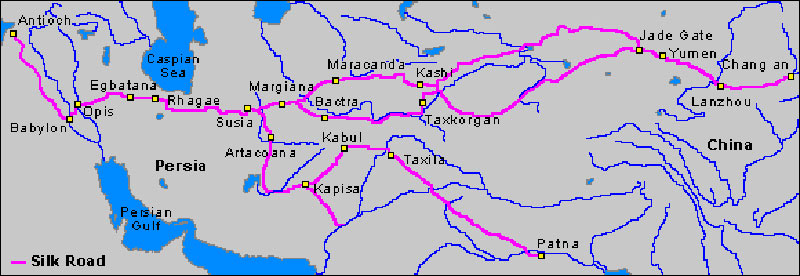
Photo source: iranchamber.com
In addition to the economic benefits, the Silk Road had many cultural effects and caused the transmission of religious ideas from the East to the West and vice versa. For example, the Silk Road played an important role in transforming Buddha’s teachings into a complex, doctrinal, diverse and practical school called “Buddhism”.
From the 7th to the 9th century, trade between China and Western countries through the Silk Road was significantly boosted. In this period, birds, rare animals, pearls, glassware, gold and silver coins, food, dance, music, western and central Asian clothes were imported to China, and Chinese silk, papermaking and printing techniques, porcelain, gunpowder and compasses were imported from this country. It was exported to other countries, which made a major contribution to the development of civilization in the world.
Silk Road trade became very popular among European merchants from the 13th century. The nature of this route, with the discovery of direct sea trade routes, connected European merchants with manufacturers in China and eliminated the role of middlemen in this economic and trade route.
With the formation of the Mongol Empire, from the 12th to the 13th century, the trade of the Silk Road fell into the hands of the Mongols. They made a lot of profit during this period. The Marco Polo family did the most trade for the Mongols during this period and were the most famous merchants of the Mongol court with Europe. With the decline of the Mongol Empire, the trade of the Silk Road fell into the hands of the Sogdians. The Sogdians were Iranians who settled in the Trans-Nahar region, in Central Asia (present-day Uzbekistan and Tajikistan). They formed a caravan and traveled from China to Central Asia and Iran.
The Byzantine Empire and its capital, Constantinople (present-day Istanbul) played a prominent role in the Silk Road trade. The merchants of Constantinople procured various goods, including silk, from the East and imported them to Byzantium, which was very popular with the people of this land. The ruling governments of Byzantium were trying to eliminate their dependence on the Persians so that they could exchange significant amounts of gold and precious stones through the Silk Road. The Silk Road worked for the Byzantine government until the attack of Sultan Muhammad Fatih, the Ottoman emperor, on the Byzantine government and the conquest of Constantinople in 1453; But the Ottoman Empire, after conquering Constantinople, ended the trade relationship with the West.
By conquering Byzantium, the Ottoman Empire took control of the western end of the Silk Road and by imposing heavy taxes on the goods that passed through this road and enforcing strict religious rules on the merchants of this road, it created barriers to the trade of the road, which eventually led to its closure. became it; Because the sea route of the Silk Road was better and easier for the Europeans than the land route.
The Silk Road was considered the most important trade route in the world from 130 BC to 1453 AD; But with the passage of time and the expansion of industry, technology and making big changes, as well as the production of silk all over the world, this road gradually lost its effectiveness.
The isolationist policies of the Ming dynasty in China at the end of the 14th century dealt the final blow to the decline of the Silk Road. Throughout the Ming and Qing dynasties, China avoided trade with the rapidly advancing West and became a country with ever more repressive laws; Finally, he issued an order to stop the flourishing and extensive trade on the Silk Road. On the other hand, Italy became the most important supplier of silk in Europe. Since then, some of the Silk Road’s side routes in Tajikistan, Afghanistan, Pakistan and India were also usable until the beginning of the 21st century.
Merchants, travelers and caravans traveling the Silk Road needed places to rest and recuperate. Iranian kings, especially Shah Abbas I of Safavid, mostly benefited from the sea route of silk trade; But he built caravanserais to accommodate travelers on the side of the roads for merchants. The remains of some of these caravanserais, which are considered to be the main elements of Iranian architecture, are still available. Historical markets were other relics of the Silk Road, the center of trade and exchange of goods by merchants and were built in cities such as Tabriz, Kerman, Yazd and Isfahan, where the main roads of the Silk Road passed by.
The Silk Road in Iran also lost its prosperity after the Safavid period. In addition to the effects of the Ottoman rule on Constantinople and the policies of the Ming government, other factors also played a role in the gradual decline of the ancient Silk Road. Lack of security, war, bandits, the emergence of new technologies and people’s efforts to produce goods and items that were previously imported to their countries through the Silk Road are examples of these cases.
Advances in technology and innovations in transportation led to cost-effective vehicles that significantly reduced the role of the Silk Road. Also, with the production of tea, this product became the main competitor of silk in the world and pushed silk out of economic prosperity. On the other hand, the speed of progress in transportation systems and the formation of the railway industry in connecting countries to each other made governments unnecessary from the Silk Road.
The reason for naming the Silk Road
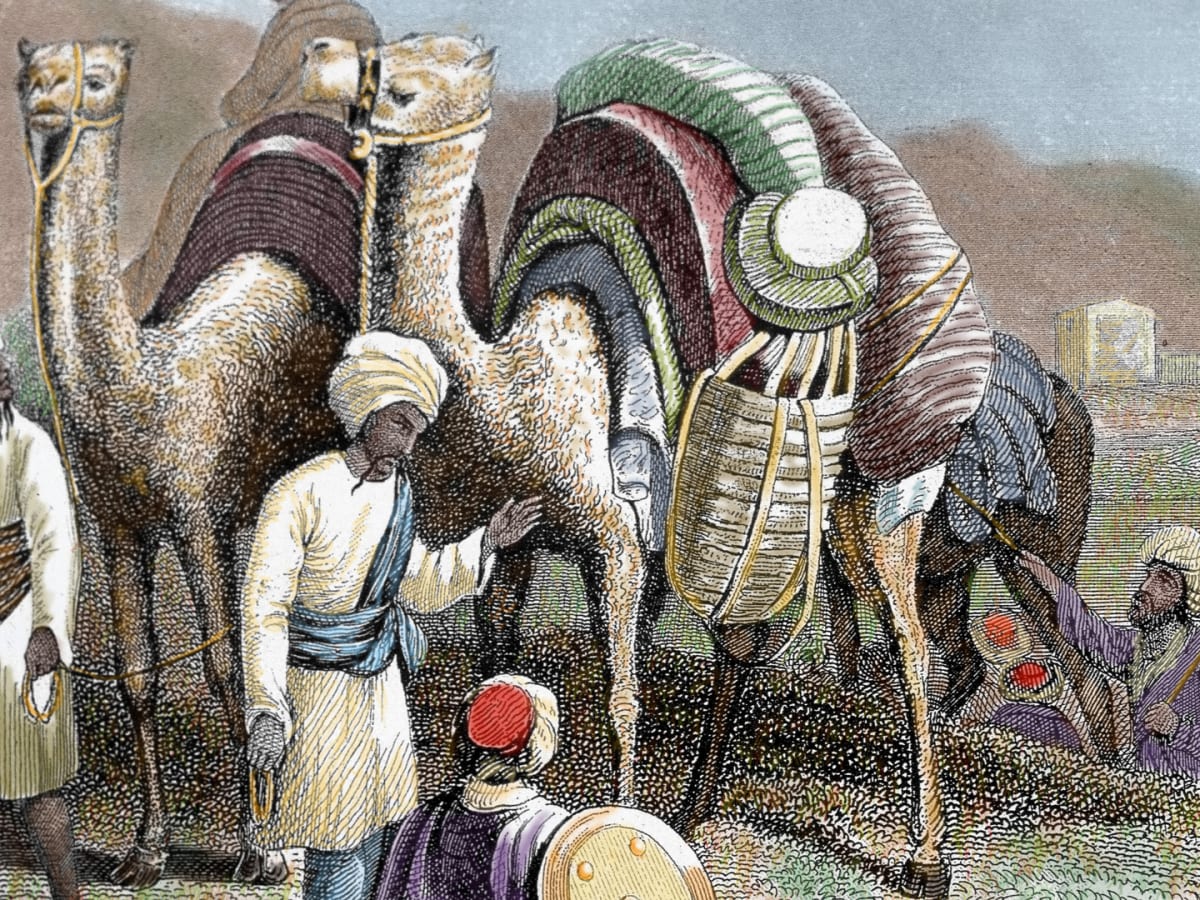
Photo source: history.com
The most famous commodity that was exchanged for several centuries in the network of trade routes between the Far East and Africa and Europe was “silk”. For this reason, the name of this route became known as “Silk Road”. Silk was produced in China and the areas close to it in the East and was considered one of the most expensive traded goods. In addition to economic benefits, this road also played an effective role in political and cultural communication. Ferdinand von Richthofen is known as the first person who gave the name Silk Road to this trade route . This German geographer chose this name for the road in 1877 because of the transportation of silk from China to the Mediterranean Sea and other areas in between.
The importance of the Silk Road among empires
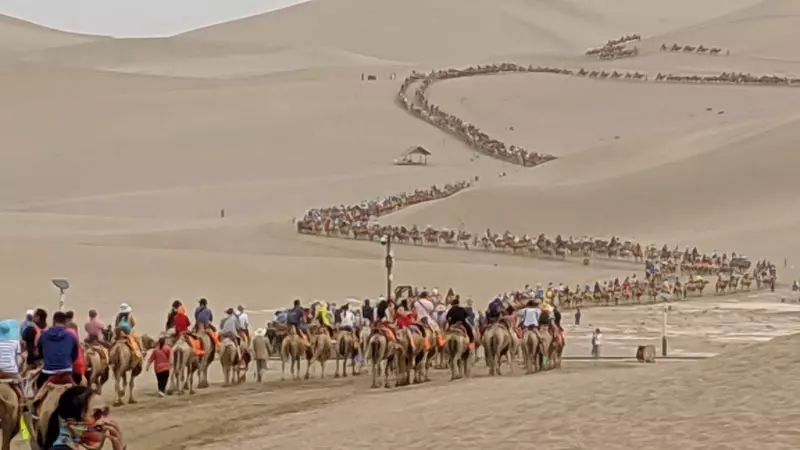
Photo source: myfamilytravels.com
The Silk Road was extremely important for the countries that were on its way. The governments of China, Iran and Rome were among the governments that benefited from the trade of the Silk Road and made many efforts for its prosperity.
The Silk Road achieved significant prosperity during the Sassanid period. During the reign of Justinian I, the Byzantine government tried to directly acquire the silk trade through the Indian Ocean by Abyssinian sailors; But Iranians had great influence in Indian ports and Abyssinians did not have the ability to compete with Iranian sailors.
Sassanid Khosrow Anushirvan closed the Red Sea route to the Byzantine government by conquering Yemen in 570 AD. The Hun Turks, who dominated Central Asia at that time, intended to trade overland with Byzantium; But to do this, they needed the consent of the Sassanid king, and Anushirvan never allowed the Byzantine government to negotiate with the Huns. The Turks decided to attack to confront Iran; But due to the strength of Iran’s borders, they failed. In 571 AD, Anushirvan conquered many parts of Turkish lands and defeated Byzantium.
In 589 AD, during the Sasanian reign of Hormuzd IV, the Turks and Byzantium united and attacked Armenia. Saveh Shah, the ruler of the Turks, also attacked Iran. Bahram Chubin faced them and won over them and returned to Iran with many spoils.
During the reign of Khosroparviz, the Sassanids became weak, and the lands of their territory that were on the Silk Road (Kashghar, Khotan, Ferghana, Takharistan and the land of the Heptals) were taken over by the Turkic Khans. For this reason, the silk trade fell into the hands of Sogdian and Khwarazmian merchants in the Central Asia region.
Silk was one of the most popular traded goods on this road; But it was not the only important export product from East to West. Trade along the Silk Road Economic Belt included fruits, vegetables, livestock, leather, hides, grains, religious objects, art tools, precious stones, and metals; It also included language, culture, religious beliefs, philosophy and science. Goods such as paper and gunpowder were invented by the Chinese in the Han government, which had significant effects on the sustainability of Western culture and political history.
The Chinese government invented paper in the third century BC and its use spread through the Silk Road. This industry first reached Samarkand in 700 BC and then went to Europe through the Islamic ports of Sicily and Spain. The arrival of paper in Europe brought significant industrial changes and added the written word to mass communication for the first time. Rich Eastern spices quickly became popular in the West and gradually changed cooking in Europe. Glass making techniques were exported from Iran to East China.
Historians point to the import of gunpowder through the Silk Road to Europe in the 1300s, which was used to make cannons in England. The origin of gunpowder is not precisely known; But many trace its history to fireworks in China. Gunpowder had a great impact on the political history of Europe and its export was very important for the European governments that used it in the war.
Silk road route
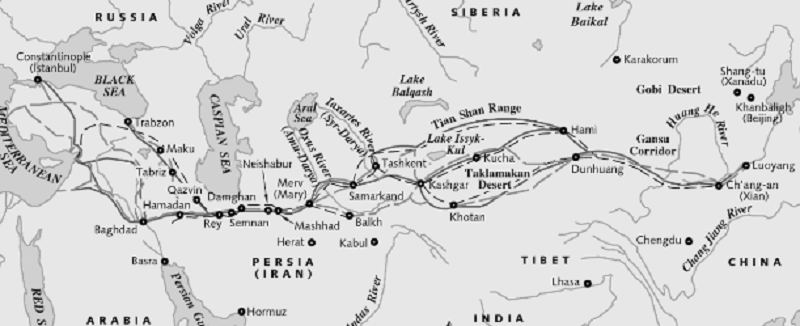
Photo source: thetispersia.com
Land Silk Road
The route of the Silk Road started from the city of Luoyang and Xian , which were among the capitals of China and were located near the Yellow River, and reached Lanzhou from the west . This road was divided into two northern and southern branches in Don Huang .
The northern branch of Don Huang reached Kashgar through Kumul or Hami, Turpan and Agsu , and its southern branch was connected to Kashgar from Khten-Parkand Square . The route of Kashgar went from Samarkand to Bukhara and from there to Merv . A route also reached from Yarkand in the south to Balkh and then to Merv . The road was connected from Merv to Neishabur and from there to Semnan , Damghan and then Ray . This route passes from Ray to Saveh, Hegmatane (today’s Hamadan), Kangavar , Kermanshah and Qasr Shirin reached; Then it was divided into two new branches upon entering Tisphon .
From Tisphon, a branch of Dora Europas (Dora Europas on the border of Syria) reached Palmyra and from there to Antioch on the Mediterranean Sea, and another branch of it went from Hotra to Nusibn and from there to Harran . Then it reached the Mediterranean Sea and from there to Greece and Rome .
The Silk Road routes formed a large network of trading posts, strategic passages, and markets designed to simplify the transportation, distribution, and storage of goods and their exchange. These routes extended from Antioch across Syria to Palmyra, Tisophon, and Seleucia on the Tigris River. The routes of Seleucia to the east also passed through the Zagros mountains and the cities of Hegmatane and Merv and reached Afghanistan, eastern Mongolia and China.
Maritime Silk Road
The Maritime Silk Road was another branch of the Silk Road that enabled trade by sea. This road reaches from Hanoi to Jakarta , Singapore and Kuala Lumpur , and through the Strait of Malacca and Colombo in Sri Lanka to South India , and then to Male , the capital of the Maldives. This sea route passed through Mombasa in East Africa to Djibouti and the Red Sea . After crossing the Red Sea to the Suez Canal , from there to the Mediterranean Sea and Haifa . And then you reach Istanbul . It was connected to Athens from Istanbul and through international free ports to Central Europe and the North Sea .
The secondary routes of this road passed through the ports of the Persian Gulf and led to the Tigris and Euphrates rivers , and from there they reached ports along the Mediterranean Sea, where goods were sent to cities throughout the Roman Empire and the European continent.
Silk Road in Iran

Photo source: samatrans.ir
The Silk Road passed through Iran in its main route and its secondary routes, and Iran, as one of the most important commercial countries along its route, played the role of transit. The most important part of the Silk Road passed through the coastal strip of Iran through Gorgan and the cities of Gilan and exited Iran from the same side. Other cities located on the main and secondary routes of the Silk Road are the cities of Sarkhs , Mashhad , Neishabur , Sabzevar , Shahroud , Bastam , Sari , Semnan , Kashan , Ray , Alamut , Qazvin , Zanjan , Hamadan ,They were Biston , Kermanshah , Sanandaj , Takab , Kandavan , Tabriz , Mianeh , Kalibar and Chaldaran .
The silk road in Qazvin city was divided into two branches; A branch of it in the northwest direction passed through the cities of Sarab , Tabriz and Khoi and from there it extended outside the borders of Iran. The other way to the west, passing through the cities of Hamadan and Kermanshah , was leaving Iran.
There were other side roads in Iran that connected to other countries through the Persian Gulf; But the most important side route of the Silk Road in Iran was the road that went from Ray to Isfahan , Shiraz and Bushehr and then left Iran through the Silk Road. This route covered the cities of Bandar Abbas , Bandar Bushehr and the borders of today’s Sistan and Baluchistan province .
Some believe that the road of Susa, which is known as the royal road and connected Susa to Sard with a length of 2,400 km, was a part of the Silk Road; While this road was built 300 years before the establishment of the Silk Road, during the time of Darius I Achaemenid. The Persians expanded the Royal Road and added smaller routes that connected Mesopotamia to the Indian subcontinent and North Africa. Alexander the Great, the ruler of the ancient Greek kingdom, expanded his dominion over Iran through the Royal Road, and eventually parts of it merged with the Silk Road.
Silk Road in Ferdowsi’s Shahnameh
Iran was considered one of the key countries that was located on the ancient Silk Road. Most of the content of Ferdowsi’s Shahnameh stories are dedicated to Iran’s relations (war, peace or trade) with nations and countries that have been on the Silk Road, such as China, Turkestan and other nations living in Central Asia. Ferdowsi mentions silk production in Iran. According to him, the quality of silk produced in Iran was such that the queen of China used it to sew her clothes.
The Persian language, which Ferdowsi had mastered, was also transferred to other lands through the Silk Road, and the people of other countries got to know it. The Persian-speaking countries in Central Asia, which include the main part of Shahnameh’s geography, are the countries that were on the Silk Road.
An international conference titled “Shahname along the Silk Road” was held on May 24, 2018 at Ferdowsi University of Mashhad, in which, in addition to the economic aspects of the Silk Road, its characteristics in the transmission of culture and language were emphasized . In this conference, in addition to confirming Iran as a point of cultural connections on the Silk Road, the cooperation of the countries located on the Silk Road route as a union was prioritized.
The most famous travelers on the Silk Road
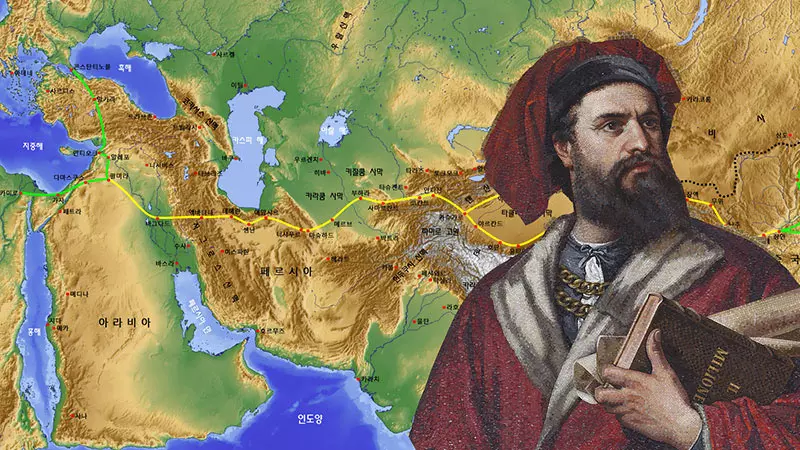
Photo source: tasteiran.net
As one of the most important international communication routes in ancient times, the Silk Road has seen many travelers and explorers, which are mentioned below in order of the year of travel:
- Zhang Qian : He was the court eunuch of Emperor Wu and the first person to investigate the western lands of the empire by order of the emperor. Zhang gave his information to the emperor in 138 BC, and the emperor opened the way of communication with the west by attacking the tribes living in western China.
- Gan Ying : The first Chinese envoy from Kashgar to Ta-Tsin (East Rome) was in 97 AD. In his journey, he traveled through the Pamir mountains to Parth, saw the coast of the Persian Gulf and visited the cities near Najaf in Iraq.
- Xuanzang: 7th century Chinese Buddhist scholar, translator, monk and traveler, also known as Hiuen Tsang. He traveled to India on the Silk Road in 629 AD to learn Buddhist teachings and collect Buddhist manuscripts, and spent 16 years of his life researching Buddhism in India.
- Saad bin Abi Waqqas : Saad bin Abi Waqqas, maternal uncle of the Prophet of Islam and a famous diplomat and missionary of that era, took Islam to China in 636 during the reign of Emperor Gaozong of the Tang dynasty. He also conveyed the news of the prophethood of Prophet Muhammad (PBUH) to Kufa in Iraq through the Silk Road and became the governor of Kufa after the fall of the Sassanids.
- Hui Chao (Hwi Chao) : Hui Chao was a Korean monk living in China who traveled from 713 to 741 AD. He went to India via the Silk Road, visited Iran and Afghanistan on the way, and on his way back he entered Xinjiang through Kashmir, Kabul and the Pamirs.
- Jamal al-Din Bukhari : Jamal al-Din was a scientist and astronomer from Bukhara who went to China in 1250 AD to establish an observatory through the Silk Road. But he failed to make it. He established an office for astronomical predictions in Beijing. Jamal al-Din also designed a chronology based on 10,000 periods for Qubila Qa’an.
- Marco Polo: Marco Polo He was a Venetian merchant and traveler who used the Silk Road to travel from Italy to China. This road was under the control of the Mongolian Empire at that time (1275 AD). Before him, Marco’s father and uncle had traveled along the Silk Road. Marco Polo went overland with his family to the summer palace of Kublai Khan, the Mongol emperor, in Shangdu and spent 24 years of his life in Asia working for Kublai Khan’s court. Marco returned to Venice in 1295 with the decline of the Mongol Empire. The results of his travels were written and preserved in the book “Marcopolo’s travel book”.
- Ibn Battuta : Shams al-Din Abu Abdullah Muhammad Ibn Battuta, a famous Muslim traveler, traveled to Eurasia and all over North Africa in 1325 to 1354 AD. He was one of the most famous travelers on the Silk Road.
- Giovanni de Marignolli (Giovanni de Marignolli) : He was from Florence and an Italian traveler who was assigned to go to China as the representative of Pope Benedict XII in 1339. He went from Organj in the south of the Aral Sea to Hami in the north of Taklimakan and from there to Beijing and Shangdu; Then in 1342, after three years, he returned to his homeland via Hormuz.
silk road map

Photo source: chinadiscovery.com
New Silk Road
The New Silk Road was established on October 3, 2013, with the aim of connecting Southeast Asian countries to the West. This road connects the continent of Asia to Europe and parts of Africa through corridors, sea bridges, land bridges and a network of special power plants. The Silk Road expands China’s economic opportunities as one of the world’s economic superpowers. This road provided new opportunities for governments to develop their trade through Europe, Africa and Asia. With the support of Europe, China took control of this road.
The name “New Silk Road” has been used to describe several major infrastructure projects that seek to expand transportation along historical trade routes; Among the most well-known of them is the Eurasian Land Bridge and the China Road, which is known as the Belt and Road Initiative; An intercontinental passage that connects China to Southeast Asia, South Asia, Central Asia, Russia, and Europe by land, and connects China’s coastal regions to each other through the Maritime Silk Road.
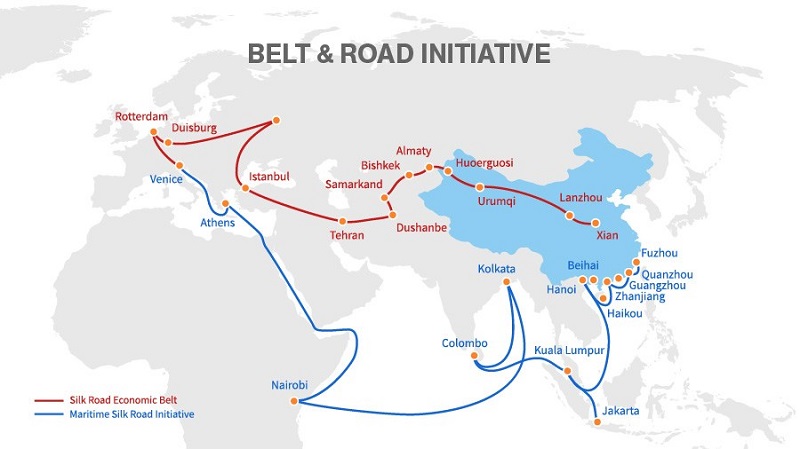
Photo source: silkroadbriefing.com
The ancient silk road was one of the most important commercial highways in the world that connected the East to the West and Europe. This road is not functional today and due to the development of societies and the growth of industry, it has fallen from commercial prosperity; But its remains are known as the ancient heritage of countries and can attract many tourists. If you have an opinion about Silk Road, share it with us and the userswhereshare it.
common questions
I am text block. Click edit button to change this text. Lorem ipsum dolor sit amet, consectetur adipiscing elit. Ut elit tellus, luctus nec ullamcorper mattis, pulvinar dapibus leo.
It was a commercial communication network that connected China to Europe
Han dynasty of China in 138 BC
Silk was the most famous commodity traded on this road
Sassanian era What was the name of Silk Road?
Silk Road was first discovered by which country and in what year?
What was the reason for naming the Silk Road?
In what period was the peak of the prosperity of the Silk Road in Iran?

